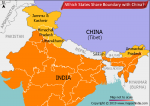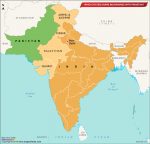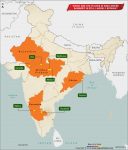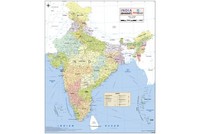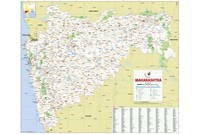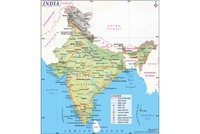“… Congress places on record its admiration of the bravery and sacrifice of Bhagat Singh, Sukh Dev and Raj Guru and mourns with their bereaved families the loss of these lives.”
~ Declaration of the Congress Party in the Karachi Session, regarding the hanging of Bhagat Singh, Sukhdev, and Rajguru, in 1931.
15 May 1907 marks the birth of a great revolutionary, Sukhdev, whose name has been instilled in the history of the war of Indian Independence, along with Bhagat Singh and Rajguru.
The history of Indian revolutionaries and their contribution to India’s fight for independence play as important a role as that of the non-violence movement practiced by Mahatma Gandhi and his supporters. According to historians, they were in fact the “forerunners of many plannings and strategies adopted by the Indian nationalists in the freedom struggle.” These include demanding complete independence, at the time when the Indian National Congress (INC) was still trying to hold on to the hope for a “dominion status”, and influencing socialist thinking, which was later adopted by the INC. Indian revolutionaries, today, are remembered as a “self sacrificing spirit” who inspired people through their bravery and heroism.
Shaheed Sukhdev Thapar was one of the famous revolutionaries of the time, who is renowned for having being part of killing a British Officer, Saunders, to protest the death of Lala Lajpat Rai. He was hanged along with Bhagat Singh and Rajguru in March, 1931.
Early Years
Born on 15 May 1907 in Naughara in Ludhiana, Sukhdev’s childhood was filled with hardships. After losing his father, Ram Lal Thapar, at a young age, Sukhdev was brought up by his mother, Ralli Devi, and uncle Achait Ram Thapar. His rebellious attitude towards the British was evident from an early age, when he refused to salute the British military officers who were visiting his school. He was caned by his teacher for such hostile behaviour. Although, it was the arrest of his uncle, that turned Sukhdev into an activist, in his adolescence.
Active Revolutionary
Joining the revolutionary movement in Punjab, brought Sukhdev in contact with several like-minded people, including Bhagat Singh, with whom he shared a close friendship. After joining the Naujawan Bharat Seva, which was founded by Singh himself in 1926, Sukhdev participated in several activities to spread political consciousness among the youth. He was also an active member of the Hindustan Socialist Republican Army (HSRA), which was established by Sachindra Nath Sanyal. Sukhdev is believed to have organised study groups and deliberated “the finer aspects of the world revolutionary literature and Russian Revolution,” at the National College in Lahore, to understand ways to fight against the British officers’ tyranny.
Lala Lajpat Rai’s Death and Consequent Incidents
The Simon Commission was sent to India to analyse constitutional reforms, and was headed by Sir John Simon and had six other British members. The Congress Party took offense to the fact, that a commission that was to decide India’s future had no Indian in the core group. This led to widespread protests across the country. The one in Lahore in 1928, was of major importance, as Lala Lajpat Rai headed the protest march with slogans like “Go Back Simon”. During the rally, the police mercilessly struck the protesters with lathis, injuring Lala Lajpat Rai badly, who later succumbed to the wounds and died.
This incident changed the course of thought among the HSRA members. They decided to avenge Rai’s death by killing James A Scott, who was responsible for the lathi charge. Sukhdev was the one to strategise the killing. Journalist Kuldip Nayar, in his book The Martyr: Bhagat Singh Experiments in Revolution, remarks that Sukhdev “provided them ideas,” and wanted to kill Scott himself. But, being the senior-most leader and the “kingpin of the network,” he was made the “planner,” and given the “role of an arbiter.” It was Sukhdev, who chose Bhagat Singh for the task of killing Scott.
His Arrest and Thereafter
The assassination of Scott did not go as planned. Instead, Bhagat Singh shot and killed by mistake J P Saunders, the then Assistant Superintendent of Police. Although, the HSRA considered this as a win, and declared that Lala Lajpat Rai’s death was avenged. Subsequently, all the people involved in the assassination tried to escape, but were captured one by one. Sukhdev was supervising in a bomb factory in Lahore, when it was raided, and he was caught possessing a loaded revolver, in March 1929.
Along with Sukhdev, Bhagat Singh and Rajguru were also arrested and imprisoned. Despite several protests to free the trio, the British took their revenge by announcing capital punishment for the assassinators Singh, Rajguru, and their accomplice, Sukhdev. During his time in jail, Sukhdev is remembered for participating in a hunger strike in order to “protest against the inhuman treatment” of inmates. He also wrote a letter to Mahatma Gandhi, after finding out that he had condemned revolutionary tactics.
Sukhdev, Bhagat Singh, and Rajguru were eventually hanged to death on 23 March 1931, at 7:33 p.m. They are still remembered with great respect for showing the zeal and valour, in India's fight for independence. It was after their death that the Congress party acknowledged their contribution, and decided to demand complete independence from the foreign rule.
Also on this day:
1817 – Debendranath Tagore, Indian philosopher, religious reformer, and father of Rabindranath Tagore, was born
1967 – Madhuri Dixit, Indian film actress, was born
References:
The Martyr: Bhagat Singh Experiments in Revolution

